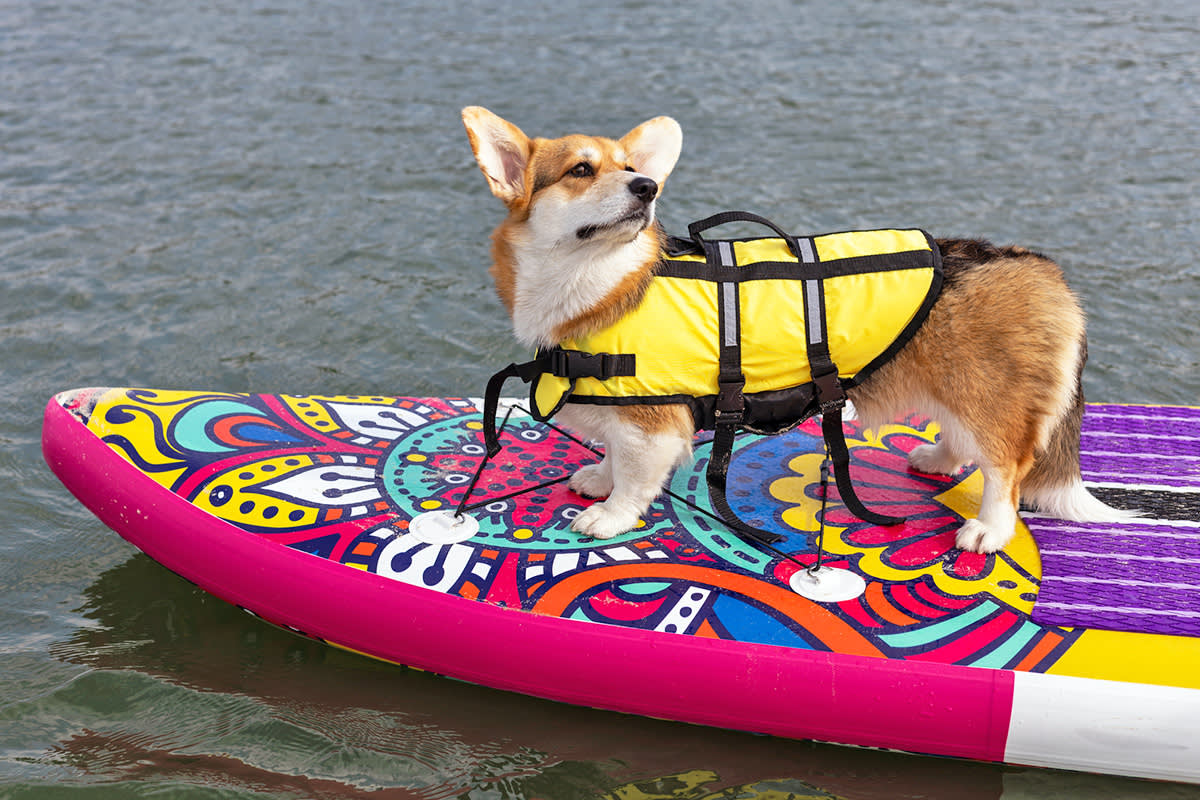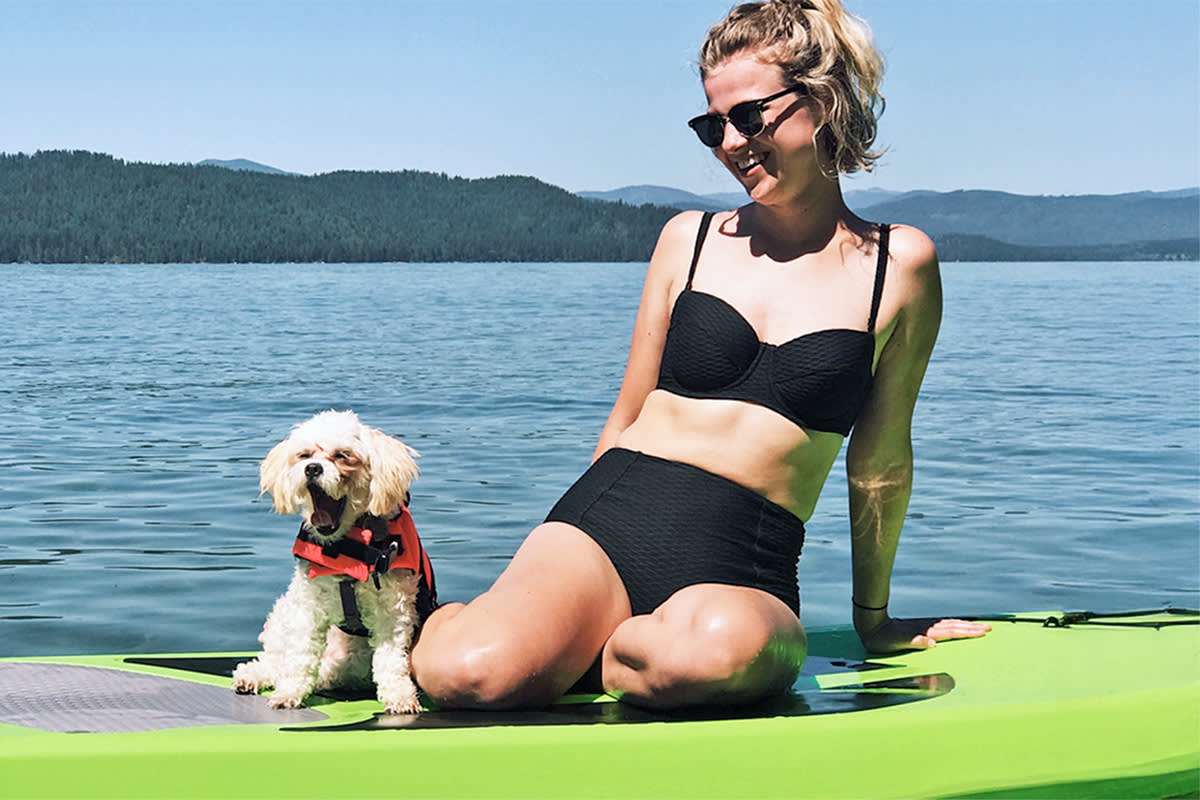Does Your Dog Need a Life Jacket? What You Need to Consider
Get all of the info before your pup hits the water this summer.

Share Article
It’s finally summer, and you are in celebration mode. You’re cracking open your favorite pale ale or seltzer and planning how you’ll spend the days. But then you remember that with summer comes new brutal 90-degree heatwaves.
Before you start googling dog-friendly VRBOs or flights to the nearest large body of water, pause and consider whether your pup has everything to put in their little suitcase (or yours, rather). If swimming is on the agenda for you both this summer, you might wonder, Do I need to pack them a life jacket? Like I would for a human child? Really?
The answer is yes in quite a few cases, but like all of the tough questions pet parents have to answer, there are a lot of factors to consider. Don’t worry, though — we’re going to go through all of them, so you can have everything you need to make your decision and have a fun, safe summer with your adventure pup.
First of all, can all dogs swim?
Some dogs can swim, yes. But, as with humans, some are more natural swimmers than others. Labrador Retrievers and other dogs who were bred specifically for water-retrieval are born swimmers. Unfortunately, nature worked against some breeds, like Bulldogs and Dachshunds, and their bodies just aren’t designed to float.
How much do you spend on your pet per year?

All of that said, some dogs who don’t look like they’d be strong swimmers take to the water like fish. Breed doesn’t necessarily determine how comfortable a dog will be in the water. That should be evaluated on an individual level, ideally with your pup wearing a life jacket at first, so they don’t panic in the water.
Is it safe to put a life jacket on your dog?
Yes, absolutely, and it could save their life.
Hannah Richteropens in new tab, New York City-based certified dog trainer and author ofopens in new tab Teach Your Dog New Tricks weighs in on when dogs should wear life jackets. “Dogs, especially those who are new to swimming, should wear life jackets in situations where there is a possibility of falling into open water,” Richter says. “Most often, this would be on a boat or in the yard near a lake or pool.”
Some argue that if a dog is wearing a life jacket during a strong current, they’ll get swept away. But if that is the case, then pet parents run the risk of their dog being swept under if they aren’t wearing a vest. Plus, the dog could grow tired attempting to swim back to shore without a life jacket.
How to decide if your dog needs a life jacket
Not all dogs need life jackets. And the dogs who would wear a life jacket on a speedboat don’t necessarily need to wear them in other situations. Ultimately, it’s your decision as a pet parent.
If you’re sitting next to your backyard swimming pool with your pup, and you know they can swim already, then you can monitor them while they take a dip in your pool. The same goes for a paddle in the lake. If you know they are confident swimmers, they don’t necessarily need a life jacket, but you should still keep your eyes on them at all times.
“Once you know how well your dog can swim, you can assess whether they need their life jacket when they are near safe bodies of water, such as a pool or lake,” Richter says. “If the water has a strong current, it is advised to have your dog wear their life jacket.”
Beyond those rules, though, how do you determine if your dog needs a life jacket?
Signs your dog needs a life jacket
Your dog has never been swimming (as far as you know).
Your dog isn’t a strong swimmer.
Your dog is going swimming anywhere with a current.
Your dog is going to be in any kind of boat or on a paddle board.
Which dog breeds should wear a life jacket?
All breeds could technically need a life jacket in specific situations. However, there are dog breeds that typically have a particular hard time swimming.
Brachycephalic breeds: Flat-faced dogs, like Pugs and French Bulldogs, have short snouts that make it difficult for them to catch their breath when strained.
Dogs with low body fat levels: Whippets, Greyhounds, and Chihuahuas have difficulty regulating their body temperature and are less buoyant.
Dogs who have longer trunks with short legs: Dachshunds and Corgis often have trouble keeping their bodies afloat.
How to train a dog to wear a life jacket
Like with any new item of dog clothing, start by taking it slow and introduce it slowly, out of the water.
“Start by putting the jacket on, feeding a treat to your dog, and then taking the jacket back off,” Richter says. “This will teach your dog that the jacket predicts good things such as food. Repeat that process three or four times for the first three days. After that, put the jacket on and then leave it on for 10 minutes or so while you play or train with your dog.”
Dog life jacket 101
What are the best life jackets for dogs?
The best life jackets should have a sturdy, grabbable handle at the top of the vest, top panels that support your pup’s natural swimming form, adjustable straps, and a clip for their leash.
They should also be brightly colored, so you can spot them from far away in the event that your dog swims too far or gets pulled out by the current. Friscoopens in new tab, Outward Houndopens in new tab, and Ruffwear opens in new tab make top-rated dog life jackets.
How do you determine your dog’s life jacket size?
Many life jackets have weight limits, so weigh your pup before you get them a life jacket. And if they’re a puppy, make sure to upgrade their life jackets if they grow into the next size up. Next, measure your pup and get their dimensions to ensure that the life jacket is going to fit.
Life jackets should fit relatively snugly — you should be able to get a few fingers underneath the straps — otherwise, your dog could swim out of the jacket if it’s too big. Before taking your pup out on any open water or going into the deep end, get them and their life jacket in the water to ensure they float. If they don’t, you need another jacket.
What water is too rough for a dog?
Any water with a strong current — this includes rivers and oceans. Dogs can be swept up by a current and struggle to make it back to shore. Like humans, they get tired in the water and can’t ingest salt water. You should always monitor your pup for fatigue, as you would keep a close eye on your dog in hot weather. They might think they’re not overdoing it, but if they begin trembling or can’t stop panting, they shouldn’t be swimming anymore.
How long should dogs swim?
It really depends on your pup. Some dog breeds who aren’t meant to be swimmers, like the ones we mentioned above, should only swim for 10 to 15 minutes. Dogs who love the water can swim more than a half hour, but pet parents should ensure they don’t get overtired.
Do life jackets actually work?
Yes, your dog’s life jacket will keep them afloat even in rough conditions. Most life jackets include foam, which is the material responsible for your pup’s buoyancy.

Alicia Kort
Alicia Kort is a writer and editor living in Brooklyn. Her work has appeared in Esquire, InStyle, Apartment Therapy, The Kitchn, Parade Home & Garden, Newsweek, Interview, Brooklyn magazine, and more. In her free time, she runs, reads, and spends time with her dog-nieces, Maya and Lady, and her cat-niece, Pepper. In her work, she focuses on pet behavior, pet-friendly spaces, and the lifestyle commerce space.
Related articles
![Black lab swimming in pool]()
How to Keep Your Dog Safe Wherever They’re Swimming This Summer
In the pool, a lake, a river, or the ocean.
Should You Give Your Dog a Summer Haircut?
For some breeds, it may do more harm than good.
![Dogs having fun at a splash park.]()
The Best Dog Water Parks Where Your Pup Can Stay Cool This Summer
They’re as adorable as they sound.
![Owner and their dog outside in the summer.]()
It’s Hot Out There—Here’s How to Protect Your Pup’s Paws
Those perfect little toe beans need all the help they can get.
![Australian Shepherd on a hill during golden hour]()
How to Hike Safely With Your Dog This Summer
Time to get your gear—and your pup—ready to go.
7 Things to Consider Before Bringing Your Dog to the Beach
You love a sandy summer moment, but will they?








